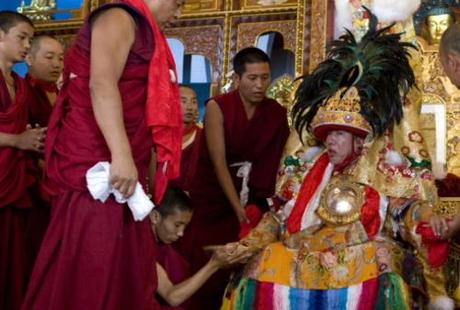When imported and variously transformed for western consumption, “Buddhism” connotes a serene sort of detachment from things and concerns of the world. But as thought and practiced elsewhere in the world (especially in what might be called homelands), “Buddhism” manifests as many things altogether different.
The textualized, intellectualized, philosophized (and in many cases, consumerized) versions found in the west hardly do justice to the many different traditions found in Tibet, China, Japan, Mongolia, Sri Lanka, and elsewhere. Twice in the past week I’ve been reminded of just how different Buddhisms can be and are.
The first reminder came from Tim McGirk, whose article “Reincarnation in Exile: What Happened When the Tibetan Buddhist Exposed Its Most Revered Adherents to Twenty-First Century Delights,” is a magnificent inquiry into the complicated world of Tibetan Buddhism, rinpoches, lamas, identity, and politics. For those not familiar with this dizzying world, it’s an ideal introduction. It should be required reading for adoring and credulous Buddhists in the west.

The Nechung Oracle in Tibet (He Enters Trance to Identify and Verify Rinpoches)
The second reminder came from a book I picked up last week as a jaunty historical diversion from my usual fare. Though I was not expecting to be given a tour through the menagerie that is Mongolian Buddhism while reading about an eccentric Russian aristocrat who wanted to be king, that’s exactly I’m getting in James Palmer’s The Bloody White Baron: The Extraordinary Story of the Russian Nobleman Who Became the Last Khan of Mongolia. The nobleman in question is Baron Ungern-Sternberg, a czarist White Russian officer with a penchant for mysticism and violence. In the telling of his bizarre and epic life, we get a sense for Tibetan-Mongolian Buddhism on the ground among real people. The picture is not pretty and may come as a shock to those prefer their Buddhism stripped down and sanitized.
One thing is clear: there is no such thing as Buddhism in the singular. There are no essential or “authentic” forms. There are many varieties, all of which are embedded in worldly histories and embodied in real people, in all their splendid and sordid varieties.

